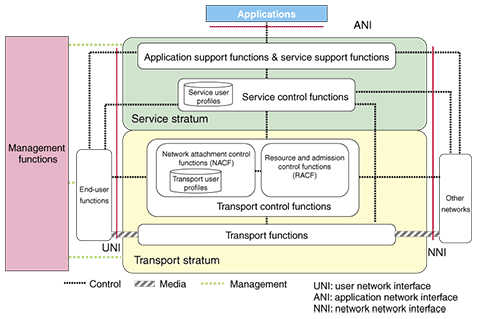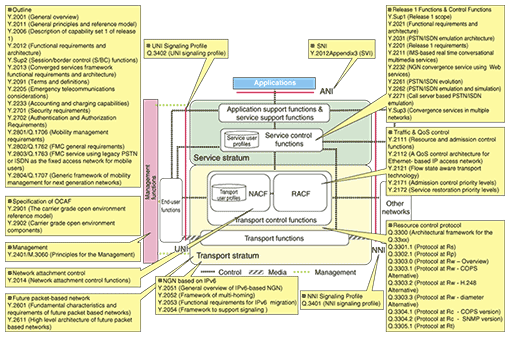 |
|||||||||||||
|
|
|||||||||||||
|
Global Standardization Activities Vol. 6, No. 11, pp. 44–46, Nov. 2008. https://doi.org/10.53829/ntr200811gls ITU-T NGN Release 1 ReadyAbstractStandardization of the next-generation network (NGN) in ITU-T (International Telecommunication Union, Telecommunication Standardization Sector) is substantially completed. Recommendations concerning the framework of Release 1 were generated from the July 2006 meeting and agreement on the main signaling systems was reached in the January 2008 meeting. This article gives an overview of ITU-T NGN Release 1, mentioning the services assumed for Release 1 and the NGN's structure, security, and signaling system.
1. IntroductionThe next-generation network (NGN) is being standardized in ITU-T (International Telecommunication Union, Telecommunication Standardization Sector) [1], [2]. With Recommendations concerning the framework of Release 1 being generated from the July 2006 meeting [3] and agreement on the main signaling systems being reached in the January 2008 meeting, standardization is substantially completed. This article gives an overview of ITU-T NGN Release 1. 2. Services assumed by NGN Release 1The scope document for NGN Release 1 (Y.Sup1) describes the possibility of many future services. However, essentially, the main objective is the implementation of interactive multimedia communication services through the exchange of voice and images between two persons (session-based services). The services are divided into two categories: PSTN/ISDN emulation services, which target seamless transition to the NGN for conventional telephone service customers, and PSTN/ISDN simulation services, which emphasize extension to future fixed-mobile convergence (FMC) and multimedia services (PSTN: public switched telephone network; ISDN: integrated services digital network). The scope of Release 1 includes implementation of both service classes. Assuming that NGN will inherit the previous communication infrastructure, services that should serve as public networks and their functions are also within the scope of study. At the January 2008 meeting, the main functions of NGN Release 1 and the signaling system were completed, and their general set of capabilities was summarized in document Y.2006. Thus, the overall picture of Release 1 is now visible. 3. NGN structureTo implement the services described above, the capabilities required of the network and the functional deployment for implementing them are specified as a functional architecture. An overview of the NGN is presented in Fig. 1. Conceptually, the network has two layers: (1) a service stratum that implements communication service functions such as provision of user authentication and registration, party discovery, call condition negotiation, and various additional services for supporting and strengthening those functions and (2) a transport stratum for end-to-end transport of IP (Internet protocol) packets that guarantees the quality of service (QoS) and security. An NGN communication service is implemented by integrating these two functions.
The connection points between the NGN and the outside are specified as the user network interface (UNI) for terminal connections, the network-network interface (NNI) for connection with other NGN networks, and the application network interface (ANI) for connection to applications. The ANI documentation, however, goes no further than presenting function models in Y.2012; further specification remains an item for future work. Furthermore, the server-network interface (SVI) was specified as a significant derivative interface in a detailed study of the three main NGN interfaces—UNI, NNI, and ANI—at the January 2008 meeting and published as an addendum to Y.2012. In the service stratum, the part that implements the basic communication service is specified as service control functions, and the IP Multimedia Subsystem (IMS) using the session initiation protocol (SIP) serves that purpose. The ITU Recommendation also allows for the implementation of call server formats, reflecting the approach of China and other countries that place importance on complete reproduction of existing telephone networks. The transport stratum provides (i) network attachment control functions (NACF) for user and terminal authentication and registration and for IP address assignment and (ii) resource admission control functions (RACF) for guaranteeing communication quality based on network usage conditions. RACF authorizes the setup to be provided in response to each session setup request according to network availability and guarantees stable quality until the call ends. 4. NGN securitySecurity is another major feature of the NGN. An analysis of attacks or threats against the NGN, a model for reliability relationships that assume security, and the conditions required for NGN security, which describe the security objectives and requirements, are being specified. Mechanisms for implementing the required conditions, authentication and authorization, and secure user ID management are among the issues currently being studied [4]. 5. NGN signaling systemITU-T SG11 (Study Group 11) is studying the NGN signaling system. Attention is focused on the main interfaces, with reference to the IMS specified by 3GPP (3rd Generation Partnership Project) and ETSI TISPAN (European Telecommunication Standards Institute, Telecoms & Internet converged Services & Protocols for Advanced Network) [5] and the detailed internal structure of the NGN. The January 2008 meeting completed specification of Q.3401 for the NNI signaling system, which specifies the SIP inter-NGN connection method, Q.3402 for the UNI signaling system, and Q.3303.2, Q.3304.2, etc. as typical interfaces for RACF. Those Recommendations reflect many NTT proposals submitted as Contributions and are grounded in domestic TTC (Telecommunications Technology Committee) standards in Japan. These and other Recommendations related to NGN Release 1 are shown in Fig. 2.
6. ConclusionNGN Release 1 assumes the implementation of session-based communication. Release 2 aims for the provision of IPTV (Internet protocol television) and implementation of true mobility. NTT Laboratories will continue to contribute actively to international standardization in the future, making the most of its leading-edge experience with the broadband environment in Japan. References
|
|||||||||||||









